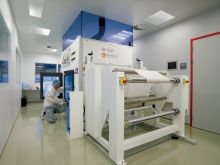Technical textiles are predominantly man-made fibre-based owing to their inherent advantages of strength and versatility. Man-made fibres are estimated to account for around 80% of the total fibre consumption in the global technical textiles.
The majority of technical textiles are manufactured using regular fibres or their specialty variants, whereas, high performance fibres account for a mere 5% of the total fibre consumption. Technical textiles refer to textile materials and products used primarily for their technical performance and functional properties rather than their aesthetic or decorative characteristics.
Today, technical textiles use 25 million tonnes of fibres, accounting for a third of global production. Since 1960, the technical textiles market has increased five times faster than traditional textiles. The nonwovens and composite markets are also set to increase significantly.
The Industry has witnessed a compound annual growth rate (CAGR) of over 3% from 2000 to 2010. Going forward, the major growth areas for technical textiles in the global context are projected to be medical and personal hygiene, sports and leisure, environmental protection, pollution control and filtration, garment and shoe industry.
The primary reason for the success of technical textiles is the innovativeness of woven, knitted and nonwoven fabrics, especially in combination with each other. Another very important aspect for the huge economic potential offered by functional textiles is the great importance given to diversification in research to promote the discovery and implementation of these innovations.
The main target of the technical protective fabrics is to improve people safety in their workplaces. A technical protective fabric can save a worker’s life, that’s why, most of them are mainly used to manufacture PPE (personal protective equipment). There are some organisations around the world (ASTM and ISO) which describe the requirements and regulations, to fulfil by a fabric, to be considered as a technical protective fabric. The aim of a technical protective fabric isn’t fashion, they are designed to have extra values in protection, against some hazards.
The US is the largest consumer of technical textiles, followed by Western Europe and Japan. However, the technical textile industry in the developed world is maturing in a significant way resulting in moderate growth in these economies. In contrast, China, India and other countries in Asia, America and Eastern Europe are expected to experience healthy growth in the near future. Asia is emerging as a powerhouse of both production as well as consumption of technical textiles. China, Japan, Korea, Taiwan and India have great potential to make an impact in this industry in the coming decade.
India is emerging as a significant player within the technical textiles market. The fast-paced economic growth leading to infrastructure creation as well as higher disposable income has made India a key market for technical textile products. Moreover, the country has developed a foothold in the production of technical textiles owing to its skilled and technical manpower as well as abundant availability of raw material.
Products being marketed in each sector can be grouped into commodity products, customized products, and niche products. The latter two are the high-value technical textiles, and the development of such products requires significant R&D support (technical textiles is included in the EU and national strategies for R&D funding support) and “know-how” in application of new technologies. Usually, these technical textile products are created in a close relationship between the manufacturer and the customer so as to ensure tailor-made solutions to specific user requirements. So, although the developing economies are major areas of the global market for growth in technical textiles (the potential in India is huge), they do not have as yet the in-depth experience in R&D and innovation management to effectively compete in the high-value end of the market.
This article comes from finance edit released



